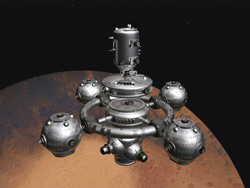Navigating through space
Spacecraft navigation is most commonly performed from the ground, where tracking stations collect and process all the distance and velocity data to determine the spacecraft's orbit. Although very accurate, ground-based navigation is expensive and requires continuous contact. It also needs time to provide the information to the spacecraft. For these reason, it is not suitable for deep space exploration whenever immediate action is needed for example during landing. For space exploration missions that will take robotic vehicles to their destination and possibly return samples to Earth, the mass to be launched and sent to orbit is also of critical importance. The EU-funded 'Small integrated navigator for planetary exploration' (SINPLEX)(opens in new window) project aimed to offer the key to significantly reducing the mass of the navigation sub-system. SINPLEX researchers developed a lightweight autonomous navigation system. This all-in-one navigation system consists of a star tracker, a laser altimeter, a video camera, an inertial measurement system and an on-board computer. Reducing mass while maintaining high performance was achieved by the miniaturisation of sensors' hardware and fusing data within a Kalman filter. 3D printing was combined with investment casting to develop a very compact housing of aluminium for the sensors. Among the benefits of this combination were huge mass savings and a high degree of functional integration of sensors' hardware. The flight model has a mass of less than 6 kg and was designed to meet the needs of landing on an asteroid, a moon or capturing a sample container while in orbit. A breadboard model of the SINPLEX system has been submitted to extensive testing to characterise the individual sensor's response, as well as its effect on overall system performance. Hardware-in-the-loop testing was performed to assess its navigation performance with representative spaceflight trajectories and to demonstrate its applicability for autonomous navigation. The test's results revealed that the SINPLEX system has the potential to be a powerful navigation system promising significant mass savings, compared to a suite of commercial off-the-shelf components with similar performances. A number of improvements needed to improve the system's performance are already in progress in order to reliably show us the way to the skies above.



